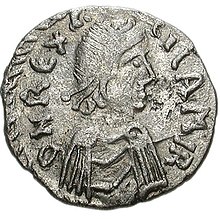
Back Gelimer Wendla Cyning ANG جيلمار Arabic جيلمار (ملك) ARZ Xelimer AST Гайламір BE-X-OLD Гелимер Bulgarian Gelimer Catalan Gelimer Czech Gelimer German Γελίμερος Greek


Gelimer (original form possibly Geilamir,[2] c. 480–553), King of the Vandals and Alans (530–534), was the last Germanic ruler of the North African Kingdom of the Vandals. He became ruler on 15 June 530 after deposing his first cousin twice removed, Hilderic, who had angered the Vandal nobility by converting to Chalcedonian Christianity, as most of the Vandals at this time were fiercely devoted to Arian Christianity.[3]
The Eastern Roman Emperor Justinian I, who had supported Hilderic, soon declared war on the Vandals, ostensibly to restore Hilderic. In June 533, Justinian sent an expeditionary force commanded by Belisarius which finally reached Africa in the beginning of September. Meanwhile, in Sardinia, which formed part of the Vandal domain, the governor Godas, a Goth, revolted against Gelimer and began to treat with Justinian as an independent sovereign. Gelimer, ignorant or contemptuous of Justinian's plans, sent a large army consisting of most of the available army in Africa under his brother Tzazo to crush the rebellion, meaning that the landing of Belisarius was entirely unopposed.[4]
On landing, Belisarius immediately marched for Carthage, finally meeting resistance on 13 September when he was confronted by Gelimer at Ad Decimum, 10 miles from Carthage. Although outnumbered 11,000 to 17,000 the battle was evenly fought by the Vandals until Gelimer's brother Ammatus was killed, at which time Gelimer lost heart and fled. On 14 September 533, Belisarius entered Carthage and ate the feast prepared for Gelimer in his palace. However, Belisarius was too late to save the life of Hilderic, who had been slain at Gelimer's orders as soon as the news of the landing of the imperial army came.[5]
However, Gelimer had escaped the Roman pursuit, and on the return of Tzazo from Sardinia the combined Vandal army met Belisarius in battle at Tricamarum about 20 miles from Carthage (December 533). This battle was far more stubbornly contested than that of Ad Decimum, but it ended in the utter rout of the Vandals and, once more, the flight of Gelimer. He retreated to Mons Pappua[6] (maybe in the Mount Edough, near Annaba)[7] on the border of Numidia, where he soon found himself besieged by Byzantine forces under Pharas.[8] According to Procopius, when summoned to surrender Gelimer instead asked Pharas to send him a loaf of bread, a sponge, and a lyre, to make the winter months on Pappua more bearable.[9]
Finally, in March 534, with his followers and their children starving and realizing he had no chance of regaining his kingdom, Gelimer surrendered to Belisarius and accepted the Romans' offer of vast estates in Galatia where he lived to be an old man. According to Procopius, on his abdication he achieved some degree of anecdotal fame by crying out the verse from Ecclesiastes1:2, 'Vanity of vanities, all is vanity' during Belisarius's triumph in Constantinople.[10]
- ^ "Missorium de Geilamir, roi des Vandales". Médailles et Antiques de la Bibliothèque nationale de France. Medaillesetantiques.bnf.fr. Retrieved 2019-04-06.
- ^ The name is attested in this form on coins and in an inscription; see J.B. Bury, History of the Later Roman Empire (London 1923), p. 126, n. 9.
- ^ The introduction of Arian Christianity to the Vandal nobility is discussed in H.E. Gieseche 1939. Die Ostgermanen und Arianismus, esp. pp. 167–99; the notorious Vandal persecutions of Catholic Christians in North Africa, recounted by the Catholic bishop Victor of Vita, is translated by John R. C. Martyn, 2008. Arians and Vandals of the 4th–6th centuries: annotated translations of the historical works by bishops Victor of Vita (Historia persecutionis Africanae provinciae) and Victor of Tonnena... (Cambridge), reviewed in The Journal of Ecclesiastical History 61, pp. 579f.
- ^ Hodgkin, III, 669.
- ^ Procopius, De Bellus III.17.11. Translated by H. B. Dewing, (Cambridge: Loeb Classical Library, 1979), vol. 2, p. 153
- ^ For possible location of Mons Pappua see J. Desanges, 1959. "La dernière retraite de Gélimer", Cahiers de Tunisie 7, pp. 429–35.
- ^ John Reynell Morell, Algeria: The Topography and History, Political, Social, and Natural, of French Africa, London: Nathaniel Cooke, 1854, p. 197.
- ^ Hughes, Ian (2009). Belisarius : the last Roman general. Yardley, Pa.: Westholme. ISBN 978-1594160851. OCLC 294885267.
- ^ Procopius, De Bellus IV.6.20; translated by Dewing, vol. 2 pp. 259f
- ^ Edward Gibbon, Decline and Fall of the Roman Empire, Vol. 4: Chapter 41: Conquests of Justinian, Character of Balisarius. Part II